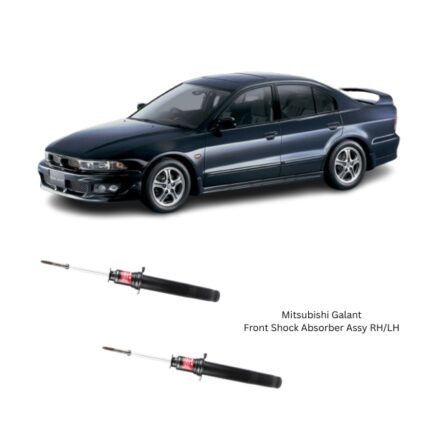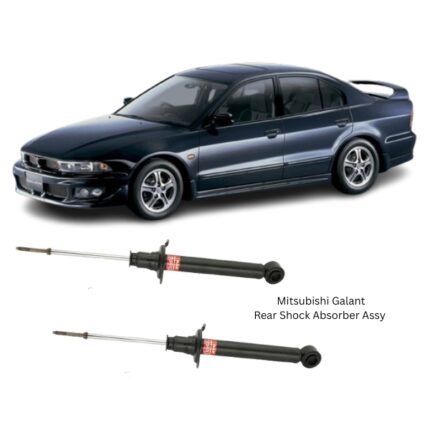Get Mitsubishi Galant GDI Rear Shock Absorber Assy 341142 in Kenya
The Rear Shock Absorber Assembly is an essential component of a vehicle’s suspension system, engineered to regulate and stabilize the movement of the rear wheels in response to varying road conditions. It plays a pivotal role in ensuring ride comfort, vehicle stability, and tire contact with the road surface during both normal driving and dynamic maneuvers.
Designed with precision and built for durability, the rear shock absorber assembly comprises a combination of hydraulic damping systems, resilient bushings, and robust mounting brackets. It helps to absorb energy generated from vertical motion—such as bumps, potholes, and load changes—by converting kinetic energy into thermal energy through controlled fluid movement within the assembly.
Function and Purpose
The primary function of the rear shock absorber assembly is to dampen oscillations and reduce suspension movement after the vehicle encounters an irregularity on the road. Without this component, a vehicle would bounce excessively, experience poor handling, and wear out tires and other suspension parts prematurely.
Key objectives of the rear shock absorber include:
-
Controlling Rebound and Compression: It restricts the speed at which the suspension springs compress and rebound, preventing loss of traction.
-
Reducing Body Roll and Pitch: During cornering, braking, or acceleration, it helps maintain chassis balance.
-
Ensuring Tire Contact: It improves braking efficiency and traction by keeping tires in consistent contact with the road.
-
Enhancing Ride Comfort: It absorbs shocks and vibrations before they reach the vehicle cabin, making for a smoother ride experience.
Construction and Design Elements
The rear shock absorber assembly consists of several precisely engineered components, each contributing to the unit’s performance, durability, and reliability.
1. Outer Cylinder (Reservoir Tube)
This is the exterior housing that contains all other internal components. It is generally made from cold-drawn steel or aluminum alloy, chosen for its strength, resistance to deformation, and ability to dissipate heat effectively.
2. Inner Cylinder (Working Tube)
Housed within the reservoir tube, the working tube is where the hydraulic fluid operates. The piston and valving system move within this tube, and it must maintain a perfect seal to avoid pressure leaks or fluid contamination.
3. Piston and Valve Assembly
The piston moves up and down inside the working tube, controlling the flow of hydraulic fluid through tiny orifices. These openings are calibrated to offer resistance during motion, which in turn dampens the suspension movement. Some assemblies include multi-stage valving for adaptive damping response depending on road conditions or load weight.
4. Hydraulic Oil
The shock absorber is filled with high-grade hydraulic fluid designed to resist foaming and retain viscosity across a wide temperature range. As the vehicle moves, this oil passes through the internal valves, converting motion energy into heat.
5. Gas Chamber (in Gas-Charged Units)
Many modern shock absorbers use pressurized nitrogen gas in a separate chamber. This eliminates aeration (foaming) of the hydraulic fluid and provides more responsive damping characteristics.
6. Rod and Seal Assembly
The piston rod, usually chrome-plated, extends from the top of the assembly and connects to the vehicle chassis. The rod moves within high-quality multi-lip oil seals, which prevent oil leaks and contamination from dust and debris.
7. Mounting Bushings and Eyelets
The assembly includes rubber or polyurethane bushings, pressed into eyelets or brackets at both ends. These provide isolation from noise and vibrations, as well as allow controlled movement and alignment of the shock absorber.
Types of Rear Shock Absorber Assemblies
Rear shock absorbers are available in several designs, with the most common including:
-
Twin-Tube Hydraulic Shock: Uses two cylinders—one for working fluid and one for reserve fluid. Ideal for daily driving and light loads.
-
Twin-Tube Gas-Charged Shock: Similar to the hydraulic version, but includes nitrogen gas to improve response and reduce fade.
-
Monotube Shock: Features a single cylinder with separate oil and gas chambers. Provides superior performance and heat dissipation.
-
Adjustable Shock Absorbers: Allow the user or vehicle system to alter damping settings manually or electronically.
-
Load-Leveling or Air-Assisted Shock: Integrated with air chambers to maintain consistent ride height under varying loads.
Each type is engineered to suit specific driving needs—from everyday comfort to off-road durability or high-performance handling.
Performance and Benefits
The rear shock absorber assembly offers a variety of benefits that directly enhance vehicle safety, comfort, and handling:
-
Improved Vehicle Stability: By controlling suspension movement, the shock absorber ensures predictable vehicle behavior, especially during cornering or lane changes.
-
Smoother Ride Quality: Minimizes the impact of road imperfections, reducing fatigue on long drives.
-
Better Load Handling: Supports varying cargo weights without compromising suspension geometry or ride height.
-
Enhanced Tire Life: Reduces uneven tire wear by preventing excessive bouncing and maintaining road contact.
-
Reduced Wear on Suspension Components: Absorbs impacts that would otherwise damage springs, mounts, or control arms.
Installation and Maintenance
Proper installation of the rear shock absorber is crucial for optimal performance. It must be securely mounted to the chassis and axle using torque specifications provided by the vehicle or part manufacturer. Worn bushings, damaged mounts, or misalignment can compromise the function of even a brand-new shock.
Signs of worn or failing rear shock absorbers include:
-
Excessive bouncing after hitting a bump
-
Noticeable rear-end sag or sway
-
Unusual tire wear patterns (cupping)
-
Fluid leaks from the shock body
-
Noisy or rough ride
-
Increased braking distance
Routine inspection is advised at every major service interval. Most shock absorbers are designed to last 60,000 to 100,000 kilometers, though this depends heavily on road conditions and driving habits.
Environmental and Engineering Considerations
Modern shock absorber assemblies are manufactured under strict environmental and safety regulations. They are:
-
Corrosion Resistant: Coated with anti-rust finishes for durability in wet or corrosive environments.
-
Heat Dissipating: Designed to handle continuous operation without thermal fade.
-
Recyclable: Composed of materials that can be processed at the end of their life cycle, including steel, aluminum, and rubber.
High-precision manufacturing processes—such as CNC-machining, robotic welding, and ultrasonic inspection—ensure the consistency and performance of each unit.
Follow us on Facebook for more parts.




